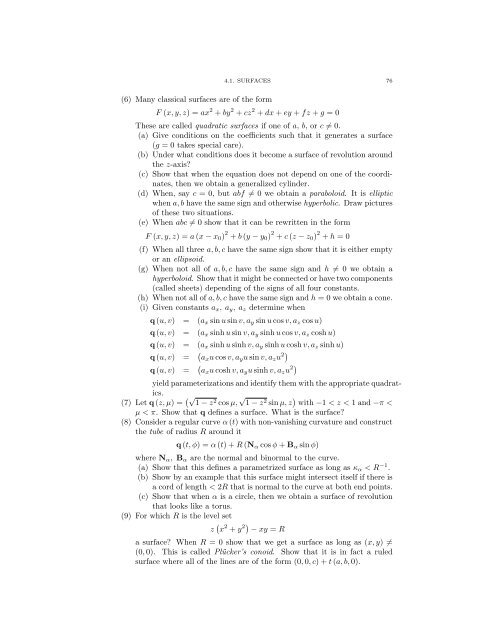Lecture Notes for 120 - UCLA Department of Mathematics
Lecture Notes for 120 - UCLA Department of Mathematics
Lecture Notes for 120 - UCLA Department of Mathematics
Create successful ePaper yourself
Turn your PDF publications into a flip-book with our unique Google optimized e-Paper software.
4.1. SURFACES 76<br />
(6) Many classical surfaces are <strong>of</strong> the <strong>for</strong>m<br />
F (x, y, z) =ax 2 + by 2 + cz 2 + dx + ey + fz + g =0<br />
These are called quadratic surfaces if one <strong>of</strong> a, b, orc 6= 0.<br />
(a) Give conditions on the coefficients such that it generates a surface<br />
(g =0takes special care).<br />
(b) Under what conditions does it become a surface <strong>of</strong> revolution around<br />
the z-axis?<br />
(c) Show that when the equation does not depend on one <strong>of</strong> the coordinates,<br />
then we obtain a generalized cylinder.<br />
(d) When, say c =0,butabf 6= 0we obtain a paraboloid. It is elliptic<br />
when a, b have the same sign and otherwise hyperbolic. Drawpictures<br />
<strong>of</strong> these two situations.<br />
(e) When abc 6= 0show that it can be rewritten in the <strong>for</strong>m<br />
F (x, y, z) =a (x x 0 ) 2 + b (y y 0 ) 2 + c (z z 0 ) 2 + h =0<br />
(f) When all three a, b, c have the same sign show that it is either empty<br />
or an ellipsoid.<br />
(g) When not all <strong>of</strong> a, b, c have the same sign and h 6= 0we obtain a<br />
hyperboloid. Showthatitmightbeconnectedorhavetwocomponents<br />
(called sheets) depending <strong>of</strong> the signs <strong>of</strong> all four constants.<br />
(h) When not all <strong>of</strong> a, b, c have the same sign and h =0we obtain a cone.<br />
(i) Given constants a x ,a y ,a z determine when<br />
q (u, v) = (a x sin u sin v, a y sin u cos v, a z cos u)<br />
q (u, v) = (a x sinh u sin v, a y sinh u cos v, a z cosh u)<br />
q (u, v) = (a x sinh u sinh v, a y sinh u cosh v, a z sinh u)<br />
q (u, v) = a x u cos v, a y u sin v, a z u 2<br />
q (u, v) = a x u cosh v, a y u sinh v, a z u 2<br />
yield parameterizations and identify them with the appropriate quadratics.<br />
(7) Let q (z,µ) = p 1 z 2 cos µ, p 1 z 2 sin µ, z with 1
















